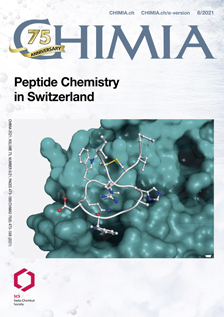Passing the Barrier – How Computer Simulations Can Help to Understand and Improve the Passive Membrane Permeability of Cyclic Peptides
DOI:
https://doi.org/10.2533/chimia.2021.518PMID:
34233816Keywords:
Cyclic peptides, Kinetic modelling, Membrane permeability, Molecular dynamicsAbstract
Proteins with large and flat binding sites as well as protein–protein interactions are considered ' undruggable ' with conventional small-molecule drugs. Cyclic peptides have been found to be capable of binding to such targets with high affinity, making this class of compounds an interesting source for possible therapeutics. However, the oftentimes poor passive membrane permeability of cyclic peptides still imposes restrictions on the applicability of cyclic peptide drugs. Here, we describe how computational methods in combination with experimental data can be used to improve our understanding of the structure–permeability relationship. Especially the conformational dynamic and chameleonic nature of cyclic peptides, which we investigate by a combination of MD simulations and kinetic modeling, is important for their ability to permeate passively through the membrane. The insights from such studies may enable the formulation of design principles for the rational design of permeable cyclic peptides.Downloads
Published
2021-06-30
Issue
Section
Scientific Articles
License
Copyright (c) 2021 Stephanie M. Linker, Shuzhe Wang, Benjamin Ries, Thomas Stadelmann, Sereina Riniker

This work is licensed under a Creative Commons Attribution 4.0 International License.
How to Cite
[1]
S. M. Linker, S. Wang, B. Ries, T. Stadelmann, S. Riniker, Chimia 2021, 75, 518, DOI: 10.2533/chimia.2021.518.







